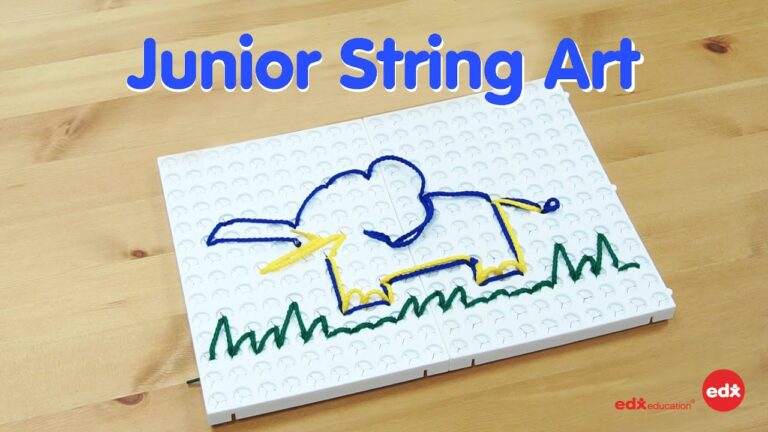String art is a creative and engaging way to teach various educational concepts to students of all ages. By combining the tactile experience of working with string and the visual impact of geometric patterns, string art can help reinforce math skills, improve spatial reasoning, and enhance creativity. In this article, we will explore the benefits of using string art in educational settings and provide tips for incorporating this versatile medium into your lesson plans.
What is the purpose of string art?
String art serves as a creative and artistic way to visualize mathematical concepts and patterns. Originating from the ‘curve stitch’ activities developed by Mary Everest Boole in the late 19th century, string art has evolved into a popular decorative craft that allows individuals to express their creativity through intricate and colorful designs. With its roots in mathematics and geometry, string art continues to inspire and engage people of all ages in the beauty of patterns and symmetry.
What is learned from string painting by children?
Children learn a variety of skills through string painting. Not only does it help with fine motor skills, but it also encourages creativity and self-expression. By manipulating the string to create art, toddlers are able to explore different textures and colors, enhancing their sensory experiences and cognitive development.
What material is ideal for string art?
For string art projects, the best material ultimately depends on the desired outcome and intricacy of the design. Delicate pieces often benefit from the use of embroidery floss, while fashion pieces and accessories may require the use of yarn or thicker threads. When looking for a versatile and durable option, consider opting for a 20-pound hemp cord spool, which offers both strength and flexibility for a variety of string art projects.
A Creative Twist on Learning: The Educational Power of String Art
Discover the mesmerizing world of string art as a unique tool for enhancing educational experiences. Through the intricate and geometric patterns created by intertwining strings, students can develop spatial awareness, fine motor skills, and mathematical concepts in a hands-on and engaging way. By incorporating string art into lesson plans, educators can ignite creativity and critical thinking skills in their students, making learning a dynamic and visually stimulating experience. Explore the endless possibilities of string art and unlock the educational power it holds in transforming traditional teaching methods into a captivating journey of discovery and learning.
Stringing Together Knowledge: How String Art Enhances Education
String art is an engaging and creative way to integrate math and art education. By using string and nails to create intricate geometric patterns, students can develop their spatial reasoning skills and understand mathematical concepts such as symmetry, angles, and patterns. This hands-on approach to learning not only enhances students’ understanding of mathematical principles, but also fosters a deep sense of creativity and artistic expression.
Incorporating string art into the curriculum can also help students develop problem-solving and critical thinking skills. As they plan and execute their string art projects, students are challenged to make decisions about design, color, and placement of nails, which requires them to think critically and make adjustments as they go. This process encourages students to think creatively and persevere through challenges, ultimately strengthening their problem-solving abilities.
Moreover, string art can be used as a tool for interdisciplinary learning, bridging the gap between math, art, and other subjects. By exploring the history and cultural significance of string art, students can gain a deeper appreciation for different cultures and time periods, while also honing their research and writing skills. This interdisciplinary approach to education encourages students to make connections between different subjects, promoting a holistic understanding of the world around them.
Unraveling the Benefits: Exploring String Art in Education
String art is a versatile and engaging way to introduce mathematical concepts to students. Through creating geometric patterns and designs, students can develop a deeper understanding of shapes, angles, and symmetry. This hands-on approach to learning not only fosters creativity but also strengthens problem-solving skills, making it an invaluable tool for educators.
Moreover, string art can also be used to teach historical and cultural concepts. By incorporating different cultural designs and patterns, students can gain a greater appreciation for the diversity of art around the world. This not only enhances their understanding of different cultures but also encourages them to think critically about the significance of art in society.
Additionally, string art provides a unique opportunity for interdisciplinary learning. By integrating subjects such as math, art, and history, students can see the interconnectedness of different disciplines. This holistic approach to education fosters a well-rounded understanding of the world and promotes a lifelong love of learning. Ultimately, string art has the potential to enrich education by providing a creative and immersive learning experience for students of all ages.
Stringing Along: Enhancing Education Through the Art of Strings
Immerse yourself in the harmonious world of strings and watch as education is transformed into a captivating and enriching experience. Through the art of strings, students are able to engage in a creative and expressive form of learning that not only enhances their musical abilities but also fosters critical thinking, discipline, and teamwork. Stringing along in this educational journey, students are able to cultivate a deep appreciation for music while developing valuable skills that will serve them well beyond the classroom.
Incorporating string art into educational settings offers a creative and engaging way for students to explore mathematical concepts, develop fine motor skills, and express their artistic abilities. By integrating this hands-on activity into the curriculum, educators can foster a dynamic learning environment that encourages problem-solving, critical thinking, and collaboration. String art not only enhances academic learning, but also promotes a sense of accomplishment and self-expression among students. As a versatile and visually captivating medium, string art serves as a valuable tool for educators to inspire and empower their students in the classroom.

